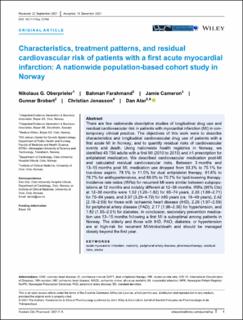| dc.description.abstract | There are few nationwide descriptive studies of longitudinal drug use and residual cardiovascular risk in patients with myocardial infarction (MI) in contemporary clinical practice. The objectives of this work were to describe characteristics and longitudinal cardiovascular drug use of patients with a first acute MI in Norway, and to quantify residual risks of cardiovascular events and death. Using nationwide health registries in Norway, we identified 43 750 adults with a first MI (2010 to 2015) and ≥1 prescription for antiplatelet medication. We described cardiovascular medication post-MI and calculated residual cardiovascular risks. Between 3 months and 13–15 months post MI, medication use dropped from 93.3% to 75.1% for low-dose aspirin, 78.1% to 11.0% for dual antiplatelet therapy, 91.6% to 78.7% for antihypertensives, and 88.0% to 70.7% for lipid-lowering therapy. Incidence rate ratios (IRRs) for recurrent MI were similar between subpopulations at 12 months and notably different at 12–36 months. IRRs (95% CIs) at 12–36 months were 1.52 (1.26–1.82) for 65–74 years, 2.26 (1.88–2.71) for 75–84 years, and 3.97 (3.29–4.79) for ≥85 years (vs. 18–49 years), 2.42 (2.18–2.69) for those with ischaemic heart disease (IHD), 2.26 (1.97–2.59) for peripheral artery disease (PAD), 2.17 (1.98–2.36) for hypertension, and 1.82 (1.65–2.01) for diabetes. In conclusion, secondary prevention medication use 13–15 months following a first MI is suboptimal among patients in Norway. The elderly and those with IHD, PAD, diabetes, or hypertension are at high-risk for recurrent MI/stroke/death and should be managed closely beyond the first year. | en_US |

